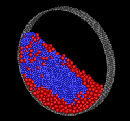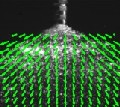|
Granular Flow: A rich variety of phenomena occur in granular flows including mixing or segregation of particles of varying sizes or densities, chaotic advection, and pattern formation. In collaboration with Julio M. Ottino, we use measurements, simulations, and theory to understand and characterize canonical flows such as granular flow in partially-filled rotating drums and heaps. The image at left shows a simulation of the segregation of particles of two sizes in a rotating tumbler. See publications here. |
|
|
Taylor-Couette Flow: The flow in the annulus between a rotating inner cylinder and a fixed outer cylinder, known as Taylor Couette flow, is a rich dynamical system. Our work covers a broad range of topics including the velocity field, stability, and chaos. An important application of Taylor Couette flow is dynamic filtration, which can be used to process blood and recycle wastewater for manned space flight. The image at left shows the experimentally-measured velocity field in wavy vortex flow. See publications here. |
|
|
Dynamical Systems, Chaos, and Mixing: Together with Julio M. Ottino, we investigate dynamical systems as related to mixing, pattern formation, and segregation. Though most work has been related to granular flows, new approaches for three-dimensional systems and for mixing via cutting and shuffling are being explored. The image at left shows how the unstable manifolds trace the segregation pattern for particles of two different sizes in a square tumbler. See publications here. |
|
|
Filtration: Pressure-driven fluid flow through a permeable material occurs in such diverse applications as filtration, aeration, sparging, foaming, membrane reactors, irrigation, transpiration cooling, and medical devices. We study many aspects of filtration from a fundamental standpoint, with particular interest in water purification and using Taylor Couette flow for dynamic filtration. This work led us to develop a unique device for reverse osmosis filtration that resists fouling that has been tested by NASA for possible use in the manned mission to Mars. We also developed methods for determining sub-nanometer pore sizes and for predicting rejection of organic and inorganic molecules by nanofiltration and reverse osmosis membranes, as well as investigated photoreactive filtration systems using nanoparticle-nanotube composites. The image at left schematically indicates the rejection of contaminants of different sizes. See publications here. |
|
|
Physical Acoustics: Acoustic measurements have the potential to provide a fingerprint for the composition of gas mixtures. The speed of sound in a gas mixture is directly related to the molecular weight of the component gases. Molecular relaxation and the classical mechanisms of viscosity and heat conduction cause the absorption of sound in a mixture of gases. We developed the first model for acoustic attenuation in multi-component gases based on quantum mechanics, kinetic theory of gases, and acoustics in order to exploit these characteristics to explore acoustic sensors to measure gas composition. We have developed a prototype gas sensor based on acoustics for NASA and explored acoustic propagation in the atmospheres of several planets. The image at left from the European Space Agency shows the Huygens probe descending to Titan, a moon of Saturn for which we have estimated the acoustic properties. See publications here. |
|
|
Fire Suppression Sprays: We made the first measurements of a fire sprinkler spray in the presence of a fire. The results have been implemented in NIST's fire simulation code. The image at left shows the experimentally-measured velocity field of a fire sprinkler spray. (No longer an active area of research.) See publications here. |
|
|
Turbulent Boundary Layers: We have contributed to advances in the calibration methods for hot-wire anemometry, the application of hearing aid microphones to measure wall pressure in turbulent boundary layers, the analysis of microphone resolution in wall pressure measurement, and the details of axisymmetric turbulent boundary layers on cylinders in axial flow.(No longer an active area of research.) See publications here. |






